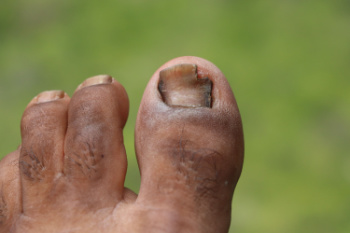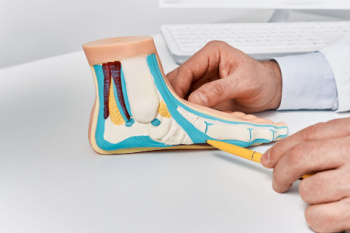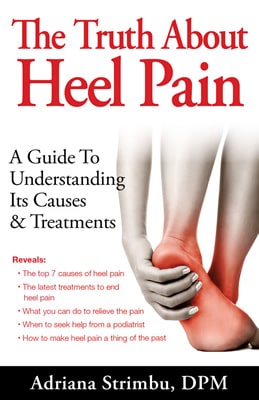Connect With Us
Blog
Items filtered by date: September 2024
Symptoms Associated With a Bunion

A bunion is a bony protrusion that forms at the base of the big toe, causing the toe to angle inward toward the second toe. This condition often results in discomfort and can lead to changes in foot structure. Symptoms include pain, swelling, and redness at the site of the bunion, along with the formation of a hard, prominent bump. Movement of the big toe can become restricted, leading to difficulty finding comfortable footwear. Risk factors for developing bunions include genetic predisposition, wearing tight or ill-fitting shoes, and conditions that affect foot mechanics like arthritis. If you have symptoms of a bunion, it is suggested that you schedule an appointment with a podiatrist who can offer you effective relief and treatment methods.
If you are suffering from bunion pain, contact Adriana Strimbu, DPM of Complete Foot & Ankle Care. Our doctor can provide the care you need to keep you pain-free and on your feet.
What Is a Bunion?
Bunions are painful bony bumps that usually develop on the inside of the foot at the joint of the big toe. As the deformity increases over time, it may become painful to walk and wear shoes. Women are more likely to exacerbate existing bunions since they often wear tight, narrow shoes that shift their toes together. Bunion pain can be relieved by wearing wider shoes with enough room for the toes.
Causes
- Genetics – some people inherit feet that are more prone to bunion development
- Inflammatory Conditions - rheumatoid arthritis and polio may cause bunion development
Symptoms
- Redness and inflammation
- Pain and tenderness
- Callus or corns on the bump
- Restricted motion in the big toe
In order to diagnose your bunion, your podiatrist may ask about your medical history, symptoms, and general health. Your doctor might also order an x-ray to take a closer look at your feet. Nonsurgical treatment options include orthotics, padding, icing, changes in footwear, and medication. If nonsurgical treatments don’t alleviate your bunion pain, surgery may be necessary.
If you have any questions, please feel free to contact our office located in Hallandale Beach, FL . We offer the newest diagnostic and treatment technologies for all your foot care needs.
Keep Your Feet Healthy So You Can Stay Active
Managing Fungal Toenails

Fungal toenail infections, or onychomycosis, can lead to discolored, thickened, and brittle nails. The infection often develops slowly and may go unnoticed initially. However, as it progresses, it can cause discomfort and make trimming the nail difficult. Fungi thrive in warm, moist environments, making the feet particularly susceptible. Factors such as walking barefoot in communal areas, wearing tight or damp shoes, or having underlying health conditions like diabetes can increase the risk of getting a fungal toenail infection. While mild cases might not require treatment, more severe infections often necessitate an appointment with a podiatrist. This medically trained foot doctor can take a small sample of the affected nail for an accurate diagnosis. Treatment may include antifungal medication, laser therapy, or minor surgery to remove the infected parts of the nail. If you have a fungal toenail infection, it is suggested that you schedule an appointment with a podiatrist for an exam and treatment options.
For more information about treatment, contact Adriana Strimbu, DPM of Complete Foot & Ankle Care. Our doctor can provide the care you need to keep you pain-free and on your feet.
Toenail Fungus Treatment
Toenail fungus is a condition that affects many people and can be especially hard to get rid of. Fortunately, there are several methods to go about treating and avoiding it.
Antifungals & Deterrence
Oral antifungal medicine has been shown to be effective in many cases. It is important to consult with a podiatrist to determine the proper regiment for you, or potentially explore other options.
Applying foot powder on the feet and shoes helps keep the feet free of moisture and sweat.
Sandals or open toed shoes – Wearing these will allow air movement and help keep feet dry. They also expose your feet to light, which fungus cannot tolerate. Socks with moisture wicking material also help as well.
If you have any questions please feel free to contact our office located in Hallandale Beach, FL . We offer the newest diagnostic tools and technology to treat your foot and ankle needs.
Common Soccer Injuries and How to Prevent Them

Soccer, while exhilarating, often leads to injuries such as ankle sprains, foot stress fractures, and blisters. Ankle sprains occur when the ligaments are stretched or torn due to sudden twists or impacts. Foot stress fractures result from repetitive stress and overuse, often causing persistent pain and swelling. Blisters develop from friction between the skin and footwear, causing painful, fluid-filled bumps. To prevent these injuries, players should use well-fitted, supportive soccer shoes and replace them regularly to ensure optimal cushioning. Proper warm-up and stretching routines help prepare the muscles and joints, reducing the risk of sprains and fractures. Additionally, keeping feet dry and wearing moisture-wicking socks can minimize blister formation. If you have endured a foot or ankle injury while playing soccer, it is suggested that you consult a podiatrist who can provide treatment and guide you on effective injury prevention methods.
Sports related foot and ankle injuries require proper treatment before players can go back to their regular routines. For more information, contact Adriana Strimbu, DPM of Complete Foot & Ankle Care. Our doctor can provide the care you need to keep you pain-free and on your feet.
Sports Related Foot and Ankle Injuries
Foot and ankle injuries are a common occurrence when it comes to athletes of any sport. While many athletes dismiss the initial aches and pains, the truth is that ignoring potential foot and ankle injuries can lead to serious problems. As athletes continue to place pressure and strain the area further, a mild injury can turn into something as serious as a rupture and may lead to a permanent disability. There are many factors that contribute to sports related foot and ankle injuries, which include failure to warm up properly, not providing support or wearing bad footwear. Common injuries and conditions athletes face, including:
- Plantar Fasciitis
- Plantar Fasciosis
- Achilles Tendinitis
- Achilles Tendon Rupture
- Ankle Sprains
Sports related injuries are commonly treated using the RICE method. This includes rest, applying ice to the injured area, compression and elevating the ankle. More serious sprains and injuries may require surgery, which could include arthroscopic and reconstructive surgery. Rehabilitation and therapy may also be required in order to get any recovering athlete to become fully functional again. Any unusual aches and pains an athlete sustains must be evaluated by a licensed, reputable medical professional.
If you have any questions please feel free to contact our office located in Hallandale Beach, FL . We offer the newest diagnostic and treatment technologies for all your foot and ankle needs.
Causes of Flexible Flat Feet

Flat feet, or pes planus, occur when the arches of the feet do not develop properly or collapse over time, resulting in the entire sole touching the ground when standing. This condition is common and often begins in childhood, with flexible flat feet being the most prevalent type. In this form, the arch appears only when the foot is lifted and disappears when it touches the ground. While many individuals experience no pain, flat feet can often cause discomfort during prolonged standing, walking, or running. Additional causes can include a tight Achilles tendons and posterior tibial tendon dysfunction, which may lead to pain and instability in the foot and ankle. Factors like genetics, aging, injury, obesity, and certain medical conditions increase the risk of developing flat feet. A podiatrist can evaluate your foot structure, recommend orthotic supports, and suggest treatments to alleviate pain. If you often experience foot problems related to flat feet, it is suggested that you schedule an appointment with a podiatrist for an exam and treatment options.
Flatfoot is a condition many people suffer from. If you have flat feet, contact Adriana Strimbu, DPM from Complete Foot & Ankle Care. Our doctor will treat your foot and ankle needs.
What Are Flat Feet?
Flatfoot is a condition in which the arch of the foot is depressed and the sole of the foot is almost completely in contact with the ground. About 20-30% of the population generally has flat feet because their arches never formed during growth.
Conditions & Problems:
Having flat feet makes it difficult to run or walk because of the stress placed on the ankles.
Alignment – The general alignment of your legs can be disrupted, because the ankles move inward which can cause major discomfort.
Knees – If you have complications with your knees, flat feet can be a contributor to arthritis in that area.
Symptoms
- Pain around the heel or arch area
- Trouble standing on the tip toe
- Swelling around the inside of the ankle
- Flat look to one or both feet
- Having your shoes feel uneven when worn
Treatment
If you are experiencing pain and stress on the foot you may weaken the posterior tibial tendon, which runs around the inside of the ankle.
If you have any questions please feel free to contact our office located in Hallandale Beach, FL . We offer the newest diagnostic and treatment technologies for all your foot and ankle needs.






